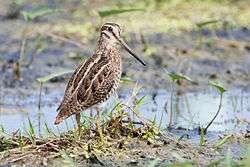Snipe
| Snipe | |
|---|---|
 | |
| Pin-tailed snipe (Gallinago stenura) | |
| Scientific classification | |
| Kingdom: | Animalia |
| Phylum: | Chordata |
| Class: | Aves |
| Order: | Charadriiformes |
| Family: | Scolopacidae |
| Genera | |
A snipe is any of about 25 wading bird species in three genera in the family Scolopacidae. They are characterized by a very long, slender bill and crypsis plumage. The Gallinago snipes have a nearly worldwide distribution, the Lymnocryptes snipe is restricted to Asia and Europe and the Coenocorypha snipes are found only in the Outlying Islands of New Zealand. The three species of painted snipe are not closely related to the typical snipes, and are placed in their own family, the Rostratulidae.
Behavior
Snipes search for invertebrates in the mud with a "sewing-machine" action of their long bills. The sensitivity of the bill, though to some extent noticeable in many sandpipers, is in snipes carried to an extreme by a number of filaments, belonging to the fifth pair of nerves, which run almost to the tip and open immediately under the soft cuticle in a series of cells. They give this portion of the surface of the premaxillaries, when exposed, a honeycomb-like appearance. Thus the bill becomes a most delicate organ of sensation, and by its means the bird, while probing for food, is at once able to distinguish the nature of the objects it encounters, though these are wholly out of sight.[1]
Diet
Snipes feed mainly on insect larvae. Snipes also eat actual flies such as crane, horse and deer flies as well as beetles, dragonflies, crickets, grasshoppers, ants, mayflies, butterflies, caddisflies and moths. Other invertebrate prey include snails, crustaceans, and worms. The snipe's bill allows the very tip to remain closed while the snipe slurps up invertebrates.[2]
Habitat
Snipes can be found in various types of wet marshy settings including bogs and swamps, wet meadows, and along rivers and ponds. Snipes avoid settling in areas with dense vegetation, but rather seek marshy areas with patchy cover to hide from predators.[2]
Nesting
The female snipe makes a shallow hole in moist soil, and then weaves a grass lining to build a nest up to 7 inches across and 3 inches deep. A normal clutch size is 2–4 eggs, with an incubation period of 18–20 days. A snipe's eggs are typically an earthy brown colour with occasional blots of brown, black, or purple. Snipe chicks will usually leave the nest upon the first day of hatching.[2]
Hunting

Camouflage may enable snipe to remain undetected by hunters in marshland. If the snipe flies, hunters have difficulty wing-shooting due to the bird's erratic flight pattern. The difficulties involved in hunting snipe gave rise to the term “sniper”, referring to a skilled anti-personnel military sharpshooter.[3]
"Going on a snipe hunt" is a phrase suggesting a fool's errand, or an impossible task. It is often used as a practical joke upon campers, and those unfamiliar with hunting, by those more experienced.[4]
See also
Footnotes
- ↑
 This article incorporates text from a publication now in the public domain: Newton, Alfred (1911). "Snipe". In Chisholm, Hugh. Encyclopædia Britannica (11th ed.). Cambridge University Press.
This article incorporates text from a publication now in the public domain: Newton, Alfred (1911). "Snipe". In Chisholm, Hugh. Encyclopædia Britannica (11th ed.). Cambridge University Press. - 1 2 3 "Wilson's Snipe, Life History, All About Birds - Cornell Lab of Ornithology".
- ↑ "snipe". Online Etymology Dictionary. Retrieved 2010-02-19.
- ↑ Palmatier, Robert Allen. Speaking of Animals: A Dictionary of Animal Metaphors. Greenwood Publishing. p. 375. ISBN 0313294909.
External links
| Look up sniper in Wiktionary, the free dictionary. |
| Wikisource has the text of the 1911 Encyclopædia Britannica article Snipe. |
- Snipe videos on the Internet Bird Collection
- http://www.fssbirding.org.uk/snipesonogram.htm